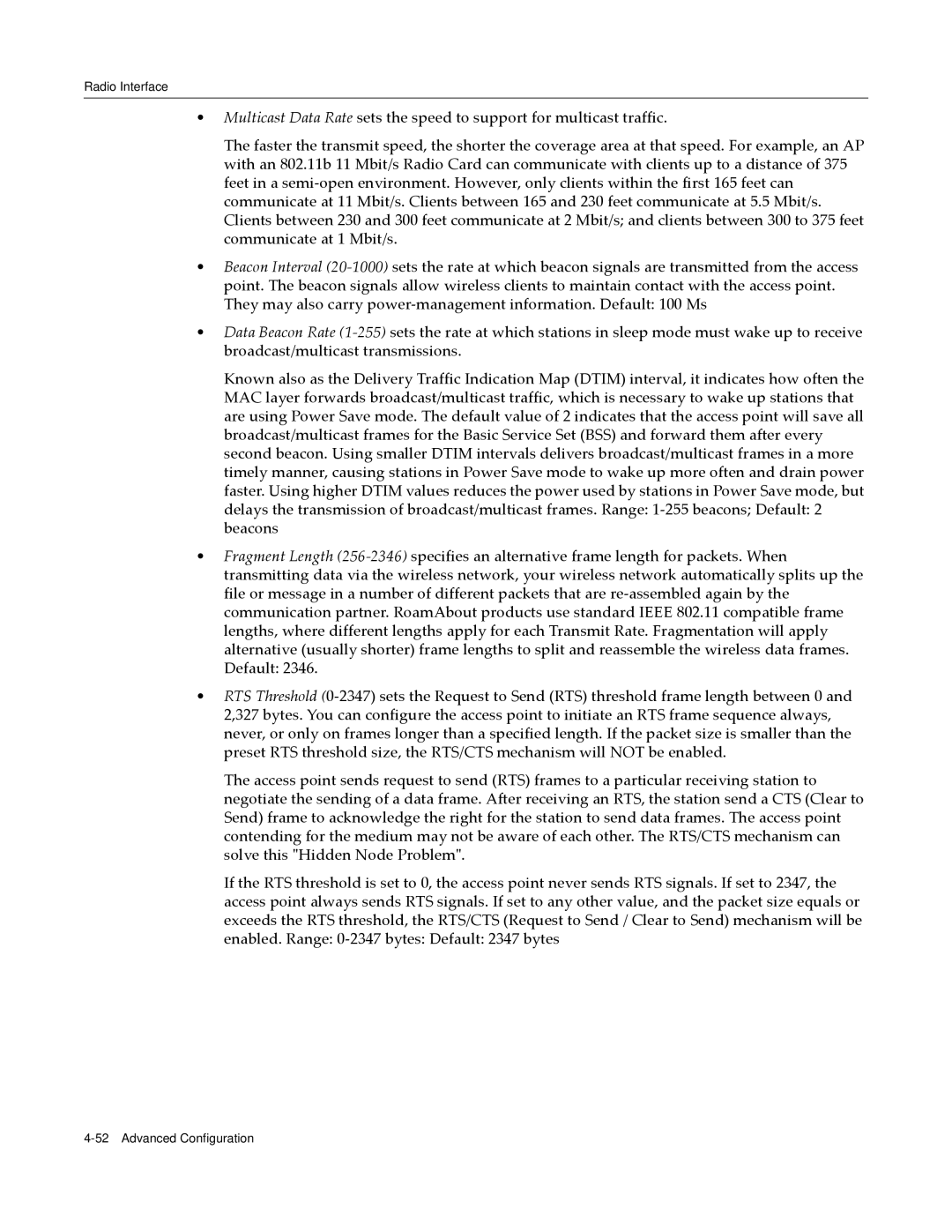Radio Interface
•Multicast Data Rate sets the speed to support for multicast traffic.
The faster the transmit speed, the shorter the coverage area at that speed. For example, an AP with an 802.11b 11 Mbit/s Radio Card can communicate with clients up to a distance of 375 feet in a semi‐open environment. However, only clients within the first 165 feet can communicate at 11 Mbit/s. Clients between 165 and 230 feet communicate at 5.5 Mbit/s. Clients between 230 and 300 feet communicate at 2 Mbit/s; and clients between 300 to 375 feet communicate at 1 Mbit/s.
•Beacon Interval (20‐1000) sets the rate at which beacon signals are transmitted from the access point. The beacon signals allow wireless clients to maintain contact with the access point. They may also carry power‐management information. Default: 100 Ms
•Data Beacon Rate (1‐255) sets the rate at which stations in sleep mode must wake up to receive broadcast/multicast transmissions.
Known also as the Delivery Traffic Indication Map (DTIM) interval, it indicates how often the MAC layer forwards broadcast/multicast traffic, which is necessary to wake up stations that are using Power Save mode. The default value of 2 indicates that the access point will save all broadcast/multicast frames for the Basic Service Set (BSS) and forward them after every second beacon. Using smaller DTIM intervals delivers broadcast/multicast frames in a more timely manner, causing stations in Power Save mode to wake up more often and drain power faster. Using higher DTIM values reduces the power used by stations in Power Save mode, but delays the transmission of broadcast/multicast frames. Range: 1‐255 beacons; Default: 2 beacons
•Fragment Length (256‐2346) specifies an alternative frame length for packets. When transmitting data via the wireless network, your wireless network automatically splits up the file or message in a number of different packets that are re‐assembled again by the communication partner. RoamAbout products use standard IEEE 802.11 compatible frame lengths, where different lengths apply for each Transmit Rate. Fragmentation will apply alternative (usually shorter) frame lengths to split and reassemble the wireless data frames. Default: 2346.
•RTS Threshold (0‐2347) sets the Request to Send (RTS) threshold frame length between 0 and 2,327 bytes. You can configure the access point to initiate an RTS frame sequence always, never, or only on frames longer than a specified length. If the packet size is smaller than the preset RTS threshold size, the RTS/CTS mechanism will NOT be enabled.
The access point sends request to send (RTS) frames to a particular receiving station to negotiate the sending of a data frame. After receiving an RTS, the station send a CTS (Clear to Send) frame to acknowledge the right for the station to send data frames. The access point contending for the medium may not be aware of each other. The RTS/CTS mechanism can solve this ʺHidden Node Problemʺ.
If the RTS threshold is set to 0, the access point never sends RTS signals. If set to 2347, the access point always sends RTS signals. If set to any other value, and the packet size equals or exceeds the RTS threshold, the RTS/CTS (Request to Send / Clear to Send) mechanism will be enabled. Range: 0‐2347 bytes: Default: 2347 bytes
